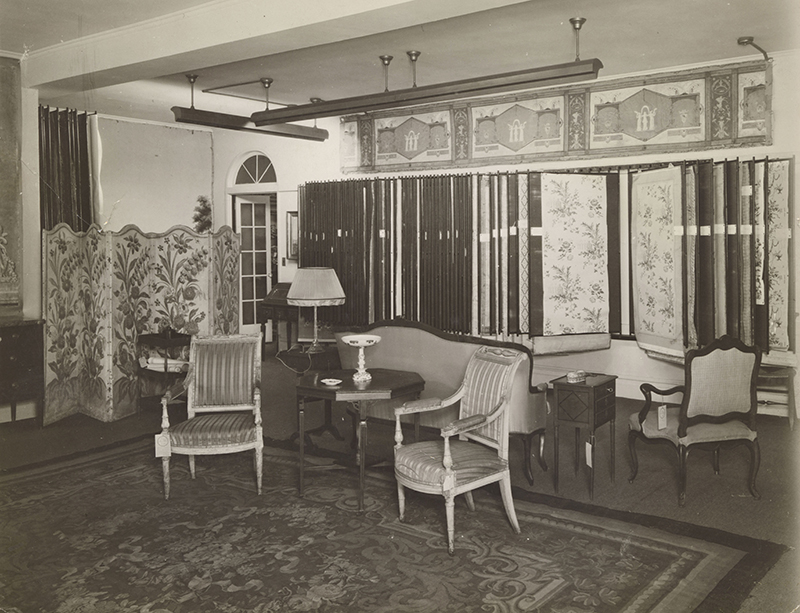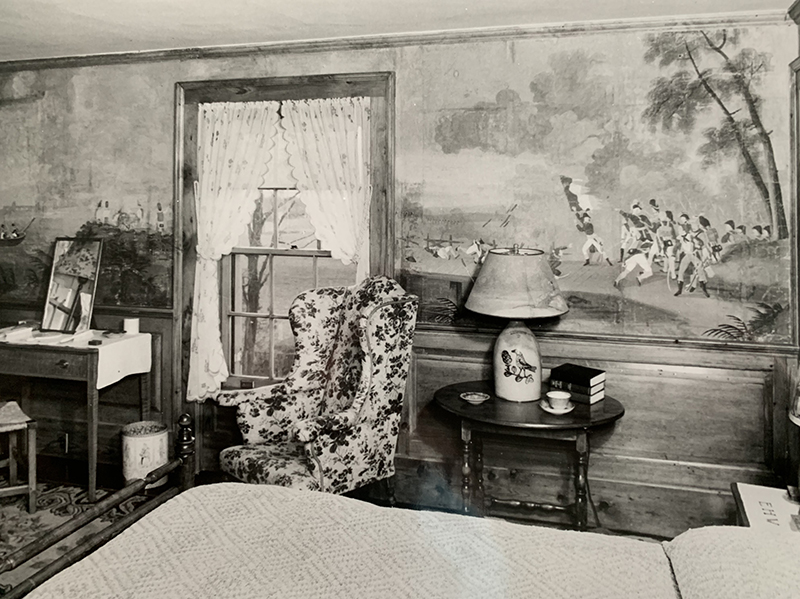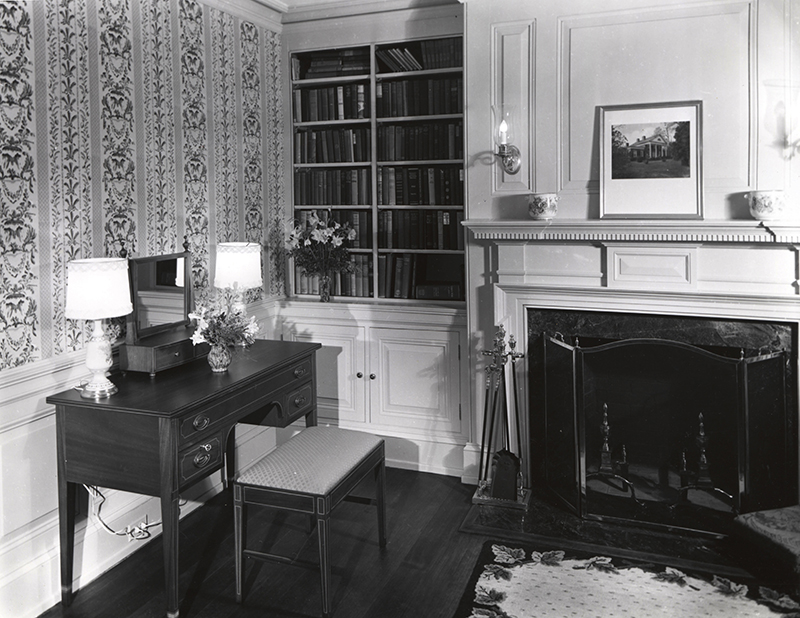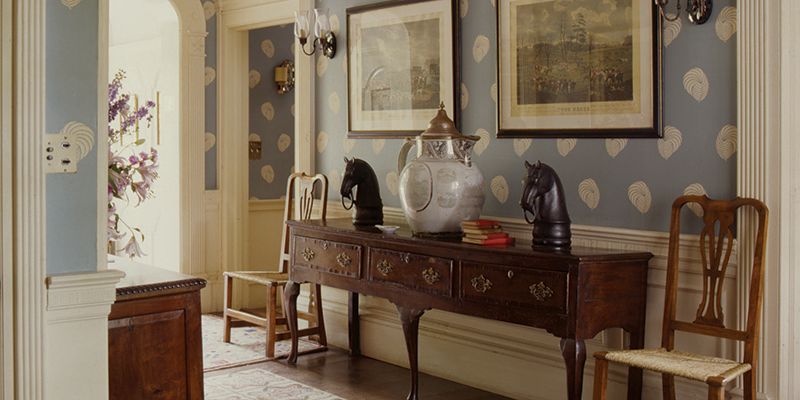Nancy McClelland: Illuminating the Scope of Her Work Through the Lens of Electra Havemeyer Webb
by Margaret Wood
Best known as an interior decorator and wallpaper historian, Nancy Vincent McClelland’s passion for wallpaper spanned decades. Throughout her nearly 60-year career, she studied, collected, produced, and used wallpapers in her practice. Her debut book, Historic Wall-Papers: From their Inception to the Introduction of Machinery (1924), proved to be one of the most important and comprehensive studies of historic wallpapers, remaining a valued resource into the 21st century.
Graduating from Vassar College in 1897, McClelland worked as a journalist before joining the advertising department at Wanamaker’s Department Store in 1901. She later founded Au Quatrième, the first dedicated antiques department at Wanamaker’s, which required her to travel to Europe on the store’s behalf up to three times per year. Taking advantage of her time abroad, McClelland began collecting wallpapers during her shopping trips. She found historic paper samples, fragments, and whole rolls, including small floral motifs from the 18th century and the 19th century’s popular scenic papers. This archive was later used for her reproduction wallpapers and featured in her many books. McClelland’s research materials, found in the Nancy McClelland Archive at the Cooper Hewitt, Smithsonian Design Museum, support the notion that she collected for both scholarly research and commercial use.
In 1922, McClelland left Wanamaker’s and opened her own firm, Nancy McClelland, Inc. in New York City. She placed wallpaper at the forefront of her business from the beginning, and early advertisements distinguish her as a “specialist in hand-blocked papers.” Wallpapers were featured prominently for clients to peruse inside the shop (figure 1). In addition to selling antique wallpapers, McClelland also printed her own wallpapers under the firm’s name. These papers were either historic reproductions of 18th- and 19th-century examples or new, modern designs. Her firm’s balance sheets indicate that McClelland’s contemporary and reproduction patterns were just as popular as her antique wallpaper inventory. Wallpaper sales often were higher than her general antique inventory. By June 1949, her gross wallpaper profits totaled $33,352 (just over $380,000 today).1
McClelland met important collectors of early American antiques as they patronized Au Quatrième and her eponymous firm. Through her writings and commissions, she established a reputation as an esteemed historian and credible source for private collectors. Electra Havemeyer Webb, for example, loved wallpaper and was known to have frequently changed the walls of the Brick House at Shelburne in Vermont.2
Shelburne’s wallpapers display the ways in which McClelland could service her clientele. In 1922, McClelland made her first sale to Webb: three panels of a wallpaper entitled Napoleon at Arcola Bridge, which was also published in Historic Wall-Papers (figure 2). McClelland provided Webb with a full history of the wallpaper, highlighting the scholarship for which she was so admired.
McClelland and Webb evidently enjoyed a close and dynamic working relationship. McClelland reproduced at least three wallpapers from fragments found on Webb’s collection of 19th-century bandboxes, including Providence House (figure 3). Photographic evidence verifies that these reproductions were not solely for Webb’s use, but also for McClelland to sell and include in her decorating projects.
Shelburne also features an example of McClelland’s contemporary work. Between 1936–1938, her firm created Feathers, which hangs in the Entrance Hall of the Brick House (figure 4). No existing documentation indicates what might have inspired the wallpaper’s swirling design. Yet, the modern sensibilities showcase McClelland’s range beyond working within the Colonial Revival style, for which she is best known.
McClelland’s numerous trips to France also enabled her to forge connections with French wallpaper manufacturers. She partnered with Mauny, a firm now owned by Zuber, to produce her reproduction wallpapers. This partnership is significant. Although many of McClelland’s competitors used modern machine-aided printing techniques, Mauny continued to generate traditional block-printed wallpapers, thereby allowing McClelland to differentiate herself from her competitors.
McClelland sent many wallpaper commissions to Mauny for reproduction. She employed designers to sketch the designs from samples found in situ, on bandboxes, or miscellaneous fragments in her collection.3 The artists who sketched the reproductions are unknown, yet it is unlikely that McClelland personally executed any of the design work herself.
As I embarked on my research, I knew little about the production process of McClelland’s reproductions. Exploring the range of wallpapers that illustrate her long relationship with Webb and Shelburne enabled me to clearly see the breadth of McClelland’s portfolio and offered insight into her varied sources.
-
- “Nancy McClelland, Inc. Balance Sheets.” August 1948 to June 1949. Nancy McClelland Archives, Cooper Hewitt, Smithsonian Design Museum.
- Kory Rogers, “Nancy McClelland Wallpaper at Shelburne” Email to Author, October 27, 2020.
- William Baldwin and Edna Woolman Chase, “Living: Notes on Decoration,” Vogue; Condé Nast New York, 1946, 195.
Margaret Wood is a MA candidate in Decorative Arts and Design History at George Washington University. Watch the Emerging Scholars Colloquium featuring her lecture on this topic in The Decorative Arts Trust Bulletin.
A print version of this article was published in The Magazine of the Decorative Arts Trust, one of our most popular member benefits. Join today!




